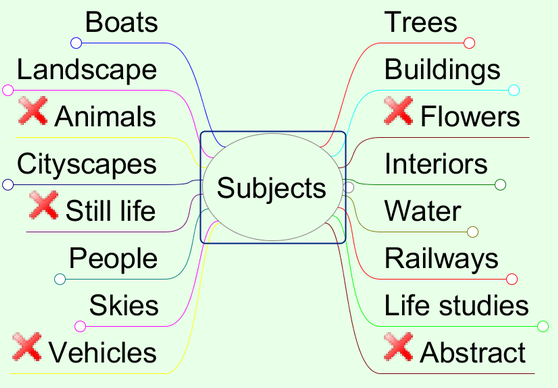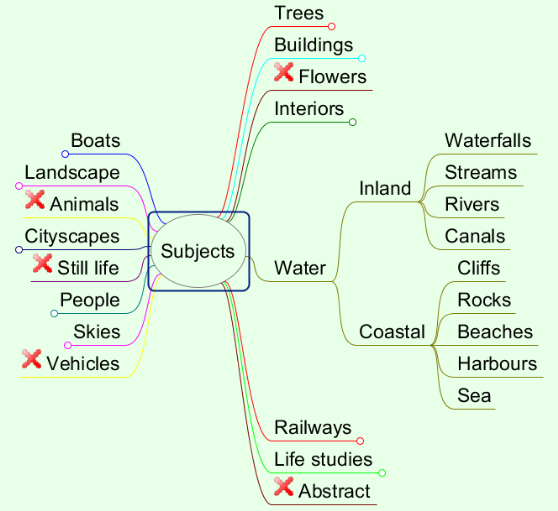WTPD 003 - Fleming Art Group
Main menu:
Watching the paint dry previous views
9 July 2013 - Love your subject
Recently I had a one year break from painting because of a back problem since solved by an operation. Last September I started back at my art groups and found that I was dissatisfied with both painting and the resulting paintings.
I tried going back to drawing, starting with a basic book, it was useful but I was still unhappy, I concentrated on watercolour pencils for a while, again useful but still it did not solve my problem. I changed medium to acrylic to try to kick start my enthusiasm which left me swearing at acrylics when I found I could not cope with the time constraint of acrylic drying. So, on the verge of giving up and finding a new hobby I went through my books looking for inspiration and finally found it in one from the library, 'Intuitive Composition' by Albert and Leslie Handel (see the book list). On the inside of the dust jacket they state;
“You must love your subject … and you must
love the materials you are working with. Its a
combination of your strong feelings for your
subject, expressed through good drawing,
strong shapes, colour, composition, and the feel
and love of the paint.
When these are intermingled … you have a language,
a vision ...and then you have art”
and that is the key, you must love your subject. I found I was using old, tired photographs dating back to when I first started watercolour at evening classes.
When we first start painting we try many subjects often under guidance from a teacher or a book or suggestions from members of art groups. The way this is done varies, at my evening class the teacher would set the subjects for a term and we go out and find photographs of them. In David Bellamy's books he has a photograph at the end of each chapter for you to interpret and then has his own painting at the end of the book. One art group, I was in, set a subject for each month and then the members voted for the best of the resulting paintings. Also at that group there was an outdoor painting programme where we would meet at a particular location to sketch and paint such as, Southampton's Ocean Village, Arlesford's Watercress Line station and so on. One art group in the US sets a particular photograph to interpret each month and, of course, many exhibitions set a theme.
All these methods are good for exploring subjects but we do not necessarily 'love them' and there is a tendency to go along with them as the path of least resistance. It may seem a straightforward matter to know what we love to paint but I have found it surprisingly difficult, probably because I am still using photographs from that time and am locked into the 'try out a new technique' syndrome.
I have started to examine subjects in what I hope is an orderly and constructive manner. The first step is to list the various subject categories and then go for a more detailed look at each.
I usually use mindmapping to organise my thoughts using an open source program called FreePlane, http://freeplane.sourceforge.net/wiki/index.php/Main_Page.
So my initial subject categorisation is as follows;

Some of these categories I know I dislike painting so I will not pursue them, these are; flowers, animals, vehicles, abstract and still life. Each of the others I expanded to give a more detailed breakdown.
As an example, the expansion for water is shown below.

The extent to which this process is taken is, of course, up to the individual artist.
Having got as detailed a subject list as you want the next challenge is to think about each subject to see what you like about it and whether it really attracts you. To help in this process I have found it useful to visit art exhibitions, local ones rather than the big galleries and make a note of the subjects of the paintings which really catch your eye.
I am in the middle of this and will let you know how I am getting on in later editions of 'Watching the paint dry.